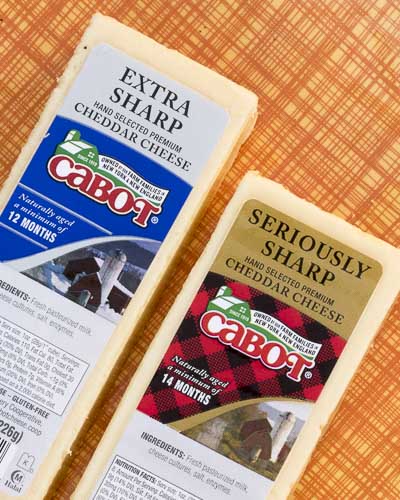Seriously, what is “seriously” sharp? You’ve seen mild, medium and sharp Cheddars at the supermarket. Maybe you’re the extra-sharp type. For some time now, I’ve been pondering what sharpness means and where it comes from. People ask me all the time what makes Cheddar sharp, and I don’t have an answer.
“It’s a nebulous term that means different things to different people,” said Paul Kindstedt, a dairy chemist and professor of food science at the University of Vermont. Kindstedt, author of American Farmstead Cheese (Chelsea Green), knows as much as anyone about the sources of flavor in cheese, but he struggled to identify the causes of that biting sensation when I reached him by phone.
“The physiology of Cheddar cheese flavor has been studied for a long time, and the magic compounds are hard to pin down,” he admitted. Typically, sharpness correlates with flavor intensity, says Kindstedt. But we all know there’s more to it than that. Some intensely flavorful Cheddars manage to be mellow, with no bite. Cougar Gold, Cabot Clothbound and Beecher’s Flagship Reserve come to mind.
Aged to perfection: Hook's Cheddar
Kindstedt highlighted a few cheese components that contribute to our perception of sharpness. Working together, they help produce that characteristic Cheddar flavor. But they are not the whole story.
Glutamic acid, the source of umami--that savory sensation that develops in aged cheese. As cheese ages, enzymes break down milk proteins and produce glutamic acid. “There’s no question that that savory background is part of the mix,” says Kindstedt. “If you didn’t have it, you wouldn’t have typical Cheddar flavor. It’s necessary but not sufficient.”
Salt. Sodium chloride allows some flavor compounds to form—they won’t form without it—and enhances those that are already present. “That’s why it’s so hard to produce low-salt Cheddar,” says the professor. “Don’t ever underestimate the role of salt.”
Lactic acid, the dominant acid in Cheddar. (Other acids predominate in other cheeses.) Different acids have different tastes. Lactic acid is “part of that (Cheddar) background, along with umami and salt,” says Kindstedt. “It all contributes to sharpness.”
Modern cultures designed to produce flavors with greater intensity. Some of these new cultures are reintroducing flavors missing in Cheddar since cheesemakers began working with pasteurized milk, Kindstedt believes. Quite likely, Cheddars produced 150 years ago were sharper because of the microflora in raw milk. “We can’t know, but I would be shocked if they weren’t,” says Kindstedt. “They had such a wide spectrum of bacteria.”
Does age make Cheddar sharper? Not necessarily. Over time, some of the volatile compounds that make Cheddars intense will peak and then change, says Kindstedt. Tony Hook, the Wisconsin cheesemaker whose 5- and 10-year-old block Cheddars are some of my favorites, told me once that his cheeses mellow with time. They gain flavor, he said, but lose bite.
Bottom line: Deciphering Cheddar flavor is complicated, and the definitive studies remain to be done. When it comes to pinpointing exactly where some flavors come from, says Kindstedt, “I’ve learned the hard way to just say, ‘I don’t know.’”
Chèvre’s Best Friend
Roasted beet and goat cheese salad—are you bored with it yet? I’m not. Sweet spring beets love a tart, fresh chèvre. Dress the beets with fennel-scented olive oil, and bake the chèvre in an oiled ramekin until soft and spreadable. You’ll find more simple, fresh spring recipes on my website.
Roasted Beets with Fennel Oil
Fennel seed’s licorice-like flavor is lovely with sweet, young beets. To capture it, I crush the seeds in a mortar, then heat them gently in olive oil just until they impart their fragrance. The strained oil makes the beets glisten, and the subtle fennel flavor is captivating. From
3/4 teaspoon fennel seeds, crushed in a mortar or spice grinder
2 tablespoons extra virgin olive oil
1-1/2 pounds small beets, preferably a mix of red and golden beets (see Note)
1 tablespoon sherry vinegar
Kosher or sea salt
1 tablespoons thinly sliced chives, optional
Heat the fennel seeds and olive oil in a small skillet over low heat until the oil is fragrant with fennel, about 5 minutes. Cool, then strain through a sieve.
Preheat the oven to 375°F. If the beet greens are attached, remove all but 1/2 inch of the stems (so as not to pierce the beets) and reserve for another use. Put the beets in a baking dish with 1/4 cup water. Cover tightly with a lid or aluminum foil and bake until a knife slips in easily, 40 to 55 minutes.
Cool slightly, then peel. Cut beets in quarters or, if very small, in half. Toss with the strained oil and sherry vinegar. Season with salt. Transfer to a serving bowl or platter and top, if desired, with chives.
Note: If using both red and golden beets, bake them separately or the red beets will stain the golden ones. Dress them in separate bowls, using half the oil and vinegar for each. Serve them alongside each other, in separate mounds.
Serves 4



